Introduction
Welcome to the website of the Astrophysical and Geochemical Laboratory, a research group of the Research Center for Astronomy and Earth Science (CSFK). CSFK was established on 1st of January 2012, in order to exploit the resources from the fusion of the largest astronomical and the three largest Earth science institutes in Hungary. Ideal possibilities opened up for joint research and collaboration in Earth science and astronomy related topics, including the start of new research fields. Using this opportunity the Astrophysical and Geochemical Laboratory was established to apply Earth science related laboratory activities in astronomical and astrophysical topics. This field became more important in recent years as the connections used here give possibility to confirm and validate astronomical observations with laboratory data. Our main research topics are the analysis of Maritan surface, young lunar craters, asteroid surfaces, meteorites and the related early evolution of the Solar System. Beyond these, the group is working on planetary analogue locations on Earth, planning and preparation of planetary missions, testing and preparing instruments in laboratories to support them.
Events
Advisory activity for the Hungarian Space Strategy Document
The Ministry of Foreign Affairs and Trade requested advisory activity from our research group in order to support suggestions for the compilation of the Hungarian Space Strategy document, which will orient the national space science and space technology activities as a framework of suggestions.
Contribution in the Comet Interceptor (Comet-I) ESA mission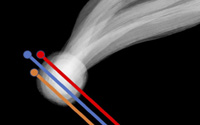
Our research group has been contributing in the development of the idea, and in later the implementation of the Comet Interceptor misson, especially in the Comet Camera (CoCa) at Co-Investigator level. Comet Interceptor will be launched without the selection of a specific target beforehand, for the first time as a space mission. It will wait at an Earth Lagrange point till a comet is discovered, which will visit the inner Solar System for the first time, and might be even an interstellar comet.
What will hit the Earth?
An invited presentaton with the title "Spectroscopical analyss of asteroids and meteorites" was given at the Világ(egyetem)hódító spektroszkópia workshop, organized by the XI. Section of Physical Sciences, Committee on Spectroscopy of Atomic and Molecular Physics, and the Committee of Space Physics, Hungarian Academy of Sciences, 12th of November 2019.
History of habitability in the Solar System
We gave an invited lecture at the
Erwin Schrödinger International Institute for Mathematics and Physics (ESI) University of Vienna during the "Astrophysical Origins: Pathways from Star Formation to Habitable Planets" international workshop in the summer of 2019.
New National Excellence grant for the work in the MMX mission
Pál Bernadett doctoral candidate received the grant of the New National Excellence Program of the Ministry for Innovation and Technology (ÚNKP-19-3) for her work related to the Japanese MMX mission. Her research is related to computational and modelling, and laboratory work for the better understanding of the thermophysical properties of Phobos, and thus, martian regolith.
Board evel role in the European Astrobilogy Institute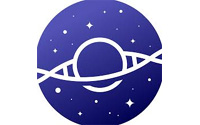 Our group coordinates the field sites related actvity of the European Astrobiology Institute, EAI, formed in May 2019. The work focuses on research activity on the origin of life from multidisciplinary aspects, connected to the next planetary missions and development of laboratory activites in the analysis of cosmic material.
Our group coordinates the field sites related actvity of the European Astrobiology Institute, EAI, formed in May 2019. The work focuses on research activity on the origin of life from multidisciplinary aspects, connected to the next planetary missions and development of laboratory activites in the analysis of cosmic material.
Exoplanet naming after the IAU call
The research group contributed to find a name for a Hungarian discovered exoplanet and its parent star. According to the Internatonal Astronomical Union, each country should propose a name for an exoplanet and its star. Our group contributed in the planning and realization of the voting and selecton representing the CSFK, and coordinating experts from linguistics, communication and civil domains in the project.
Collaboration with the japan MMX-mission
Pál Bernadett doctoral candidate contributed in the preparation of the MMX-mission at the Department of Systems Innovation, Faculty of Engineering, University of Tokyo, Miyamoto Laboratory, where she realized laboratory tests with the UTPS-TB Phobos regolith simulant. The one month long visiting work was supported by the Tempus Közalapítvány, Campus Mundi (EFOP-3.4.2-VEKOP-15-2015-00001, 303538) project.
Follow the water on Mars for children We gave an invited presentation at the a Street Science MTA Víznap event on the possibility of liquid water on Mars for primary and secondary school students at the headquarter of the Hungarian Academy of Sciences.
We gave an invited presentation at the a Street Science MTA Víznap event on the possibility of liquid water on Mars for primary and secondary school students at the headquarter of the Hungarian Academy of Sciences.
Scholarship to the climatic research institute in Paris
Pál Bernadett docoral candidate spent twice one week at the Laboratoire de Météorologie Dynamique Paris in 2017 and 2018. The visiting research work was supported by the TD 1308 Origins and Evolution of life on Earth and in the Universe, COST action, 39045 and 39078 projects.
Extreme cold but liquid (MTA workshop)
Our research group gave an invited presentation at the Academy titled "Extreme cold but liquid - possibilites of brines on Mars today" at the meeting New results from the Academy supported research projects in astronomy and Earth sciences on 13th of February 2019. Model calculations were presented on the occurrence of microscopic liquid phase on Mars, and the related observational possiblities of ExoMars rover of ESA.
Presentation at the ESA PECS closing event
We gave an invited presentation at the closing ceremony of the ESA PECS projects at the Ministry of Foreign Affairs and Trade based on the results of our former ESA projects for the national and ESA experts on 8th of October, 2018.
Co-Investigator for HABIT We achieved Co-Investigator status (Co-Investigator) for the HABIT (HabitAbility, Brine Irradiation and Temperature) instrument onboard the ExoMars rover of ESA. The instrument aims to identify the occurrence of microscopic liquid water (e.g. brine) and UV radiation on Mars. Bernadett Pál PhD candidate contributes in the work with making forecasts for the liquid occurrence using Mars climate modelsto understand the deliquecence process.
We achieved Co-Investigator status (Co-Investigator) for the HABIT (HabitAbility, Brine Irradiation and Temperature) instrument onboard the ExoMars rover of ESA. The instrument aims to identify the occurrence of microscopic liquid water (e.g. brine) and UV radiation on Mars. Bernadett Pál PhD candidate contributes in the work with making forecasts for the liquid occurrence using Mars climate modelsto understand the deliquecence process.
Extraterrestrial hydrospheres
Invited lecture was presented at the A hidroszférák jellemzői a Földön kívül workshop was realized by the Section of Earth Sciences of the Hungarian Academy of Sciences, Subcommittee on Geochemistry, Mineralogy and Planetary Science on 14th of November, 2018 at the CSFK Institute for Geological and Geochemical Research.
Testing of ESA ExoMars rover field trial 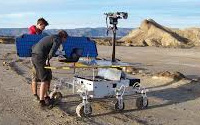 Contribution was made in the field testing of the ExoMars rover in Tabernas Desert with drilling and borehole-wall scanning in Spain, during the ESA ExoFIT project for preparation of the Mars surface rover mission.
Contribution was made in the field testing of the ExoMars rover in Tabernas Desert with drilling and borehole-wall scanning in Spain, during the ESA ExoFIT project for preparation of the Mars surface rover mission.
Contribution to the HERA asteroid mission
Laboratory analysis of meteorites under room and space relevant temperatures is started to support the HERA mission of the European Space Agency. The mission will aim to analyze the Didymos double near-Earth asteroid after NASA DART mission has hit it, to better understand the reaction of the asteroid and its geeral characteristics. Ágnes Skultéti is working on the laboratory analysis of meteorite powders and chips.
Career orientation talk for students
As a part of the PÁLYAEST project, interactive discussion was realized with secondary school students to popularize careers in astronomy, physics and Earth sciences at the H13 Diák- és Vállalkozásfejlesztési Központ, organized by the mienkapalya.hu group at 31st of January, 2019.
Laboratory work in France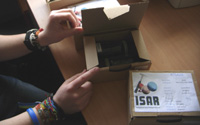 Between 14-19 March, 2016 group member Zsuzsanna Kapui visited the Centre de Biophysique Moléculaire in Orleans, France, using the support of COST-STSM-TD1308-32028 project. With Frederic Foucher and Frances Westall discussion on the International Space Analogue Rockstore (ISAR) was made, some measurements were also realized on them and sample acquisition happened for further laboratory analysis in Hungary. The project aims to support the interpretation of the drills of ExoMars rover in order to reconstruct past environmental conditions on Mars.
Between 14-19 March, 2016 group member Zsuzsanna Kapui visited the Centre de Biophysique Moléculaire in Orleans, France, using the support of COST-STSM-TD1308-32028 project. With Frederic Foucher and Frances Westall discussion on the International Space Analogue Rockstore (ISAR) was made, some measurements were also realized on them and sample acquisition happened for further laboratory analysis in Hungary. The project aims to support the interpretation of the drills of ExoMars rover in order to reconstruct past environmental conditions on Mars.
Martian meteorite analysis in Athens
Between 1-7th of February, 2015 Ildiko Gyollai group member visited Dr. Elias Chatzitheodoridis's laboratory at the National Technical University of Athens, under the research project titled “Martian meteorite analysis for astrobiology”, supported by the COST TD1308 action (STSM-TD1308-010215-053644-53644). During the work three Martian meteorites (Nakhla, Governador Valadares, Lafayette) were analyzed by Raman spectroscopy and back-scattered electron microscopy, mainly to search for and analyze secondary minerals formed by Martian water related acitivty. After the visiting research, the samples were acquired and further investigated in Hungary.
Melting inside an ancient planetesimal
Melting produced chondrule disruption was observed inside the NWA 1465 CV3 meteorite, which was produced in the relatively deeper interior of the parent body. In the sample strong mechanical deformation, two generation of opaque mineral formation, and results of resorption plus melting were identified. The results fit into the joint CV-CK parent body hypothesis with heterogeneous internal structure at this ancient planetesimal. The results were published in
Planetary and Space Science.
Student research work to predict liquid water on Mars
Pál Bernadett undergraduate master student at ELTE astronomy is working on to predict the ideal locations and periods for the emergence of microscopic liquid water on Mars today, to support the research work of ExoMars rover. According to the current phase of the work, nighttime periods might be favourable for the liquid even at low latitude terrains. She presented her results at the International Conference of Physics Students (12-19th August 2015, Zagreb) where she received the second best poster award of the meeting.
Realization of an international astrobiology conference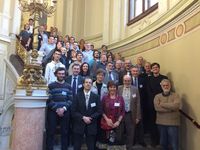 Our research group with the help of the COST TD1308 consortium organized an international conference titled Missions to Habitable Worlds between 28-29 October, 2015 at the central building of the Hungarian Academy of Sciences. Around 100 participants attended the meeting, with 32 lectureres from abroad, including the director fo the ESA Solar System Directorate, the DLR in Berlin, the head of the ExoMars, JUICE, CHEOPS and PLATO missions, together with other representatives of several European research laboratiores, and the NASA SETI institute. The program with presentations can be downloaded from here with an abstract book of the conference.
Our research group with the help of the COST TD1308 consortium organized an international conference titled Missions to Habitable Worlds between 28-29 October, 2015 at the central building of the Hungarian Academy of Sciences. Around 100 participants attended the meeting, with 32 lectureres from abroad, including the director fo the ESA Solar System Directorate, the DLR in Berlin, the head of the ExoMars, JUICE, CHEOPS and PLATO missions, together with other representatives of several European research laboratiores, and the NASA SETI institute. The program with presentations can be downloaded from here with an abstract book of the conference.
Repository Home accreditation
The Meteoritical Society gave an official Repository Home status to our research group and the CSFK home institution.
Signatures of plastic deformation in a meteorite
Unusual, elongated dark stripes were identified and analyzed by our research group in the NWA 3118 CV3 meteorite. These ripple-like features in the matrix are longer than 0.3 mm and resemble certain chondrule rims - although several of them occur without chondrules. If similar features will be identified in other meteorites, revision will be necessary on the origin of certain chondrule rims. The ripple-like features might formed just before the solidification of the meteorite's material and oriented crystal growth could also contributed in their origin. The related paper was published in Planetary and Space Science.
Microscopic chemical processes on Mars
On the surface of the red planet the only possible phase for the occurrence of liquid water is at microscopic scale today. Our group in collaboration with the ESA PECS Co 4000105405 (No. 98076) project's researchers analyzed these locations. Although the chemical conditions in this so called interfacial water differ substantally from that of the bulk volume, using reaction kinetic computations, we predicted the decomposition rate of H2O2 at these locations. Based on the result the decomposition is not ideal today, but could be much better if conditions change little on Mars. The occurence of H2O2 as the strongest oxidant on the surface is of high importance because it influences several chemical processes, and habitability too. The related paper can be read in Planetary and Space Science.
Infrared microscopic analyis of meteorites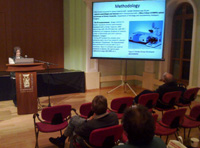
Using the FTIR Vertex 70 and Hyperion 2000 infrared spectroscope and microscope (provided by the Infrastructure Fund of the Hungarian Academy of Sciences) new results and related methodological developments were presented by Ildikó Gyollai (Thermal and Shock Metamorphosis in NWA-5011 L6 Chondrite) and Ákos Kereszturi (Infrared spectral analysis of chondrule alteration in NWA 2086 CV3 meteorite), furthermore the infrared study of aqueously altered meteorites by Sándor Góbi ("Investigating the hydration of CM2 meteorites by IR spectroscopy") in Sopron 1st of November, 2014 at "The Modern Analytical Methods Applied to Earth and Planetary Sciences" international conference.
Microgravity geology - where shall we land on an asteroid?
Exotic processes dominate on the surface of minor bodies with weak gravity. Although this so-called microgravity geology is a poorly explored field yet, it already helps in the planning of landing sites for next asteroid missions. Our group compared the different surface unit types on asteroids in order to identify ideal regions for the planned ESA mission of MarcoPolo-R. The related paper was published in the Planetary and Space Science.
Astromineralogy Workshop III.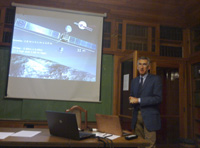
Between the 29th and 30th of September, 2014, a two day long workshop was organized by the CSFK on the connections between astronomy and laboratory work. The program of the meeting can be read here. Altogether 37 participants took part in the meeting, including 4 foreign invited guests. During the workshop the emphasis was given to the expected full ESA membership of Hungary, and in connection with this topic Luigi Colangeli, head of ESA Solar System Division gave an overview presentation. The website of the MTA also published a report on the event.
Alteration processes in the CV chondrite parent body based on the analysis of NWA 2086 meteorite
During the analyzis of the NWA 2086 CV3 type meteorite, members of our research group identified rims with double layered structures were around several chondrules, which, in at least one case, were attributed to an accretionary origin. The rim’s outer parts with a diffuse appearance were formed by in situ chemical alteration. This specimen demonstrated both type of processes that took part in the rim formation of these primitive meteorites. The related paper appeared in Meteoritics and Planetary Science, providing more insight into the buried source region of these meteorites.
Visit at the meteorite laboratory of Wrocław Univ. of Technology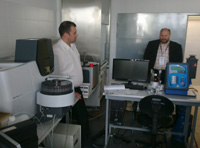
Ákos Kereszturi visited the meteorite laboratory of the Wrocław University of Technology, Faculty of Geoengineering, Mining and Geology; lead by Prof. Tadeusz Przsylibszki, the editor the "The Meteorites", the first open access journal focusing exclusively on meteorites. Consultation on laboratory facilities, especially with the representative of the Shimazu company also happened.
Interstellar dust production simulation continued
Sándor Góbi spent 3 months at the Laboratory Astrophysics and Cluster Physics Group in Jena in the spring of 2014. He has been working on the formation of interstellar carbonaceous dust simulants by laser ablation of graphite. These have been investigated at very low temperature and pressure in solid argon matrix by IR and UV-VIS spectroscopy.
Presentation of meteorite research activity at CSFK in Poland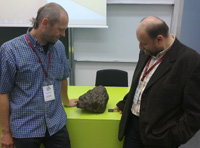
Our group gave invited oral presentation at the VIII Meteorite Conference, Wroclaw, 27-29th June, 2014 on the analysis of CV-CK chondrites, IR spectroscopy and microscopy, extraction of organic materials from chondrites, and analysis of their hydration. Related to the presentation, ideas for possible joint work emerged with members of the Polish Meterite Society and other local researchers.
Lecture day at the Academy
Our group contributed in the 185th General Assembly of the Hungarian Academy of Sciences in the Scentific meeting of the Committee on Astronomy and Space Physics, at the XI. Section of Physical Sciences. We presented two lectures: Wet trendline in the analysis of the Solar System (Ákos Kereszturi) and Small Near-Earth objects in the age of space based astronomy (Csaba Kiss) on 8th of May, 2014.
Laboratory visit at the Space Research Centre in Warsaw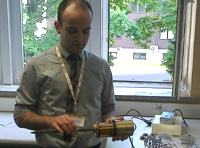
Ákos Kereszturi visited the research laboratories at the Space Research Centre of the Polish Academy of Sciences in Warsaw. During the laboratory visits successfully compiled satellite equiopments were demonstrated, and also equipment development related projects that are currently going on. Among them the theoretical backround and the working of a BREADBOARD on an electronically driven penetrator and rock breaker was demonstrated in detail.
Succesfull COST proposal
Our research group won an international COST proposal titled Origins and evolution of life on Earth and in the Universe (ORIGINS), TD COST Action TD1308, that aims astrobiology related collaboration in Europe beginning at the spring of 2014. Altogether 20 EU member states and Slovenia take part in the action, Hungary is represented by the MTA Research Center for Astronomy and Earth Sciences.
Succesful TET proposal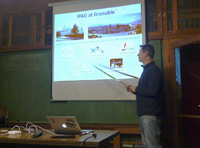
We won an international mobility proposal called TET (FR1_2013_00023) together with France on the exchange and visit of researchers between our institute and the Institut de Planétologie et d'Astrophysique de Grenoble. Under the collaboration meteorite analysis is being realized. During the first visit Prof. Eric Quirico and Alexandre Garenne visited Hungary in December 2013. The work is supported by the Nemzeti Fejlesztési Minisztérium and the Széchenyi Terv.
Interstellar dust simulant production
Melinda Krebsz worked 3 months at the Laboratory Astrophysics and Cluster Physics Group in Jena during the autumn of 2013. The work aimed at the production of interstellar dust simulant in vacuum and its spectral analysis.
ISSI Mars group collaboration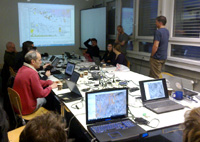
We started scientific collaboration at the International Space Science Institute on the project titled Mapping the northern plains of Mars: origins, evolution and response to climate change with 12 persons from 9 countries. The kick-off meeting was succesfully realized between 4-6th of December, 2013 in Bern, Switzerland.
NASA invitation
Ákos Kereszturi was an invited evaluator at the NASA SSERVI 13 [NNH13ZDA006C] board in Washington, at the Lunar Sceince Institute for funding projects on meteorites and asteroids.
Hydration of meteorites
Sándor Góbi worked 3 months at the IPAG institute of the University of Grenoble during the autumn of 2013 on the analysis of the 3 micrometer IR absorption band visible in charbonaceous chondrite meteorites. The work included the development of new sample preparation method for analysis with KBr pastilles.
Organic material extraction from meteorites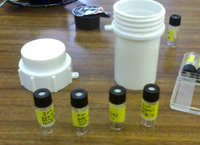
Melinda Krebsz worked 3 months at the IPAG institute of the University of Grenoble during the spring of 2013 on the extraction of organic material from carbonaceous chondrites. The work is going on currently, the first results were presented at the 76th Annual Meteoritical Society Meeting in Canada.
Lecture in the Academy
In the "New results of the Hungarian Academy Supported research projects in Earth Science"
symposium Ákos Kereszturi gave a lecture at 13th February 2013 on some
specific topics of the Laboratory’s activity titled "In the search for water beyond the Earth with Earth science methods".
Collaboration with the Jena Laboratory Astrophysics and Cluster Physics Group
Sándor Góbi and Ákos Kereszturi visited the Laboratory Astrophysics and Cluster Physics Group in Jena on 29th January, 2013 to discuss joint research work with Cornelia Jaeger and Gaël Rouillé researchers.
Collaboration with the IPAG Laboraty in Grenoble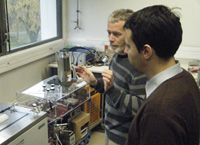
Melinda Krebsz, Sándor Góbi and Ákos Kereszturi visited the Institut de Planétologie et d'Astrophysique de Grenoble
between 28th and 29th November 2012 and discussed the possibility of
joint research with Bernard Schmitt, Eric Quirico és Pierre Beck
researchers. As part of the joint activity Melinda Krebsz started
research work on meteorites at the IPAG laboratory in February 2013.
Acquisition of a Fourier Transformational Infrared Spectrometer
With the support from the Hungarian Academy of Sciences in 2012, on the
development of academic research institutes’ infrastructure, CSFK
successfully acquired a Fourier Transformational Infrared Spectrometer,
and a Hyperion 2000 microscope. The two equipments are aimed to use for
cosmic material analysis.
Organization of the first Mars conference in Eastern Europe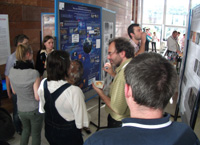
Members of the laboratory organized the international meeting titled
"Workshop on Mars – Connecting Planetary Scientists in Europe" between
5th and 7th June 2012 in the main building of the Hungarian Academy of
Sciences and the Academy’s research building at Budaörsi út. Altogether
122 participants were present at the meeting from 18 countries. More
details on the conference can be found here.
Organization of the Astromineralogy Workshop II.
The members of the laboratory organized a small workshop on 12th March
2012 at the Astronomical Institute. During the symposium Prof. Thomas
Henning (Max Planck director) gave an opening keynote presentation. The
program of the meeting can be read here.
Altogether 10 hungarian researchers gave oral presentations on their
field of research, focusing on the laboratory based material analyzing
methods and their space related applications. Altogether 22 participants
took part in the meeting, that was terminated by a joint lunch with
discussion.